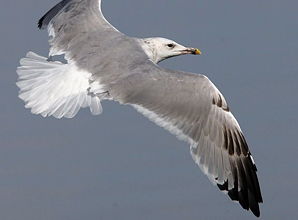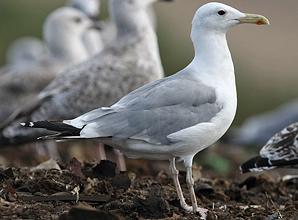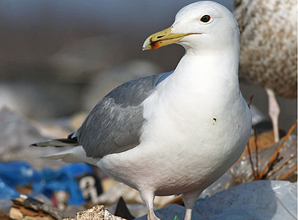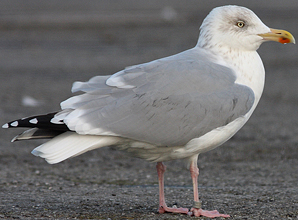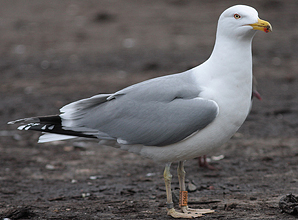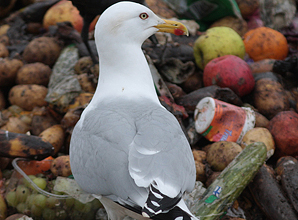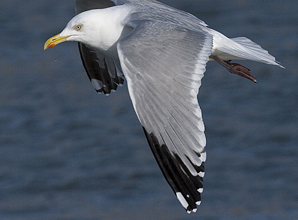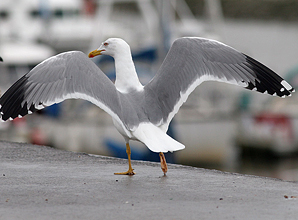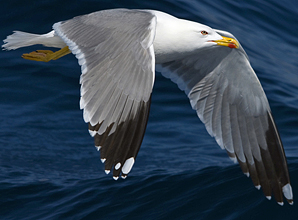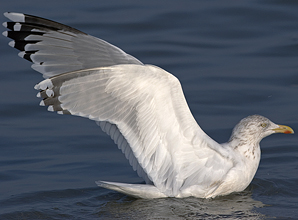 Larus cachinnans
Larus cachinnans
(last update:
Greg Neubauer
Marcin Przymencki
Albert de Jong
Mars Muusse
In 2010, Chris Gibbins, Brian J. Small and John Sweeney published two extensive papers in Britsih Birds, dealing with Caspian Gull. Below, you will find the content of the first paper "Part 1: typical birds".
Part 1: INTRODUCTION & IDENTIFICATION
Part 2: JUVENILES (1CY birds in July–September)
Part 3: BIRDS IN THEIR FIRST WINTER (1CY/2CY birds in October–April)
Part 4: BIRDS IN THEIR FIRST SUMMER (2CY birds in May-September)
Part 5: BIRDS IN THEIR SECOND WINTER (2CY/3CY birds during October-April)
Part 6: OLDER IMMATURE PLUMAGES (3CY–5CY birds)
Below, we continue with PART 7: ADULTS. "we" in the text below refers to the original authors. If any errors occur in this text, please let me know and mail to marsmuusseatgmaildotcom.
Adults
Adult Caspian Gulls are best located in gull flocks by a combination of their peculiar jizz, and relatively dark, small-looking eyes that contrast with the white head (plate 86). Identification can then be confirmed by detailed study of bill proportions, primary pattern, bare-part colours and upperpart tone. The following sections deal with these features in turn; plates 87–96 show a selection of adult cachinnans, michahellis and Herring Gulls.
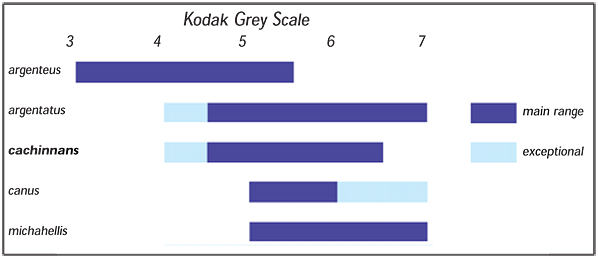
Fig. 2. Upperpart grey tones as represented on the Kodak Grey Scale for cachinnans and similar
taxa. Common Gull Larus canus is included as a good tonal match for cachinnans; values are for
nominate canus. The michahellis values exclude the Atlantic island populations (atlantis), which have
darker grey tones (from 7–7.5) than Iberian and Mediterranean birds. Values are based on Malling
Olsen & Larsson (2003) and Jonsson (1998).
Plumage
Fig. 2 shows the range of adult upperpart
tones for cachinnans and similar taxa, at least
in a British context. The figure uses the
Kodak Grey Scale, a scale that has numbered
increments from 0 (white) to 20 (black). The
scale itself is not reproduced here and most
gull-watchers will not go into the field armed
with a copy of it; fig. 2 simply compares the
upperpart tones among the various taxa and
shows the degree of overlap between them.
For grey-tone comparisons to be reliable,
other taxa should be directly alongside or
nearby. Observers also need to be aware of
the effects of light and viewing angle on the
perception of tone. Diffuse sunlight or overcast
conditions are best: strong direct sunlight
tends to bleach out subtle differences.
Another problem is that the grey tone may
appear to change on the same individual as it
faces in different directions relative to the
observer; upperparts tend to look darkest
when the bird is facing obliquely towards or
away from the observer. Thus, a slightly
darker-backed gull in a flock might just be
facing in a different direction from the
others. Any apparent difference should be
confirmed by seeing the bird in a variety of
positions.
The tone (darkness) of the pure grey upperpart feathers of adult and near-adult gulls is of quite limited value in cachinnans identification, because it overlaps extensively with that of other species. Nonetheless, it can be useful when looking for the species among paler-mantled argenteus in Britain (although most darker birds will turn out to be argentatus or michahellis, depending on location and season). To the practised eye, cachinnans can be located in flocks of michahellis by their subtly paler upperpart tone. Common Gull is usually a close match for cachinnans and, when alongside, can be used as a tonal marker.
Regardless of tone, there is a subtle difference in colour hue between the upperparts of cachinnans and Herring Gull, when seen in good light and in direct comparison. That of cachinnans is a more neutral, silky grey, with less of a bluish hue than either argentatus or argenteus. The upperparts of michahellis are more of a slate-grey. The human eye is a per perceptive tool and it is certainly possible to see the differences in colour hue between these species in direct comparison. However, because of differences between how observers perceive and describe colour, it is difficult to articulate the differences here, in words.
Wing-tip pattern
Adult cachinnans have a characteristic wingtip
pattern and, particularly when multiple
features in the wing-tip are used simultaneously,
this can be a good means of identification
(fig. 1 and plate 49). However, the
wing-tip pattern is not truly diagnostic,
because of a degree of overlap with argentatus Herring Gull.
The outermost primary (P10) of cachinnans is black, except for a long, pale 'tongue' on the inner web (grey on the upperside of the feather, white on the underside) and a long white tip. The black separating the tongue from the white tip is narrower than the length of white tip. This pattern is never seen in michahellis and is very rare in argenteus; however, it is common in argentatus. The details of the P10 pattern may be difficult to see well on flying birds (except, of course, in photographs) but can often be seen on a standing or swimming bird by viewing the underside of the folded wing. Occasional variations in the P10 pattern of cachinnans include cases where the pale tongue breaks through the black to merge with the white tip – a pattern typical of Thayer's Gull L. (glaucoides) thayeri.
An
example of this from Ukraine is shown by
Liebers & Dierschke (1997, plate 289), while
CG has seen such birds in Romania (Lake
Histria, September 2006). These locations
suggest that the 'thayeri pattern' occurs occasionally
in pure cachinnans, rather than being
indicative of introgression with Herring Gull.
Some birds show a small amount of black
within the long white tip of P10: of 31 adult
cachinnans examined in the hand by Liebers & Dierschke (1997), 11 showed a subterminal
black band (complete or incomplete) across
the tip of P10. There is also variation and
overlap among the taxa with respect to the
exact shape of the pale tongue, especially
between cachinnans and argentatus (Gibbins
2003). To reiterate, the P10 pattern is not
diagnostic.
Long, pale grey tongues are also present
on the inner webs of P7–P9 of cachinnans and, collectively, these give the impression of
pale wedges eating into an otherwise black
wing-tip. This pattern is very different from that of michahellis (which has a solid
black wing-tip) but is
seen on many argentatus.
Black extends
inward as far as P5 on
cachinnans and on
some (16%; Jonsson
1998) also to P4.
Ideally, a candidate cachinnans should have
a black band extending
unbroken across both
webs of P5, typically
slightly less deep than
that of michahellis.
However, there is considerable
variation in
the pattern of black on
P5 of all the taxa.
Around 10% of cachinnans lack a complete
black band on P5
(Jonsson 1998): such
birds may have isolated
marks on both the
inner and outer webs
of the feather (plate
49) or have black
restricted to the outer web. Herring Gulls
may lack black on P5 altogether (e.g. many
Norwegian argentatus), have black only on
the outer web (frequent in argenteus) or have
black on both webs. When black is present on
both webs of P5 in Herring Gull, it may be as
an isolated black spot on each (usually larger
on the outer web), or as a complete band
(plate 90). When present, the band is usually
much narrower than on michahellis, but it
matches many cachinnans. Black on both
webs of P5 is a surprisingly common feature
in eastern Baltic populations of Herring Gull
(Malling Olsen & Larsson give a value of
30%), so these birds are a real cause of confusion.
Overall, the variability in P5 pattern
means that it is difficult to give definitive criteria
regarding its value in identification. Like
cachinnans, Herring Gulls can have black
extending inwards as far as P4, though this is
rare.
Some have argued that eastern and western populations of cachinnans differ with respect to primary pattern (e.g. Stegmann 1934). Adults from eastern populations normally have a less extreme wing-tip pattern, where the long white tip of P10 is regularly interrupted by small black spots on each web, sometimes merging to form a subterminal band. A significant proportion show black on P4 (50%; Jonsson 1998). Compared with western birds, eastern cachinnans may also show shorter pale tongues invading the black of the upperwing, but these still break up the black of the outer primaries in a way that michahellis never shows. More research is needed to determine whether eastern and western cachinnans deserve formal subspecies status.
Head pattern
The head of adult cachinnans normally
appears unmarked (plate 87). Any streaks are
extremely fine, often confined to the lower
rear neck, and usually only apparent at close
range for a limited period in autumn (plate
88). In michahellis, streaking is also usually
apparent only in the autumn but is concentrated
around the face and ear-coverts. On
average, this streaking is clearer than shown
by cachinnans at this time. Streaking disappears
in late autumn, as feathers wear. From
early autumn to mid/late winter, the vast majority of Herring Gulls show a variable but
usually obvious degree of dusky streaking
and/or blotching on the head and neck (plate
90). There are exceptions and it is possible
(though uncommon) to find clean-headed
argenteus and argentatus before January, just
as it is possible to find the odd Black-headed
Gull Chroicocephalus ridibundus with a full
hood in mid-winter.
Bare parts
Outside the breeding season, the bill of
cachinnans is normally a rather weak,
greenish-yellow, fading to grey-green basally.
There are frequently some dark marks (small
spots or crescents) in the gonys, while the red
is usually less bright than for either michahellis or Herring Gull. Thus, in general, the
bill of cachinnans in winter stands out as
being duller than that of the other species.
However, as many argentatus have washed-out,
greeny-yellow bills in winter, bill colour
and pattern is merely a supportive feature.
The bill becomes a richer yellow in late spring and, during the breeding season the bill coloration of cachinnans overlaps with that of Herring Gull. Neubauer et al. (2009) argued that, unlike the orbital ring (see below), bill tones do not differ consistently between cachinnans and Herring Gull in breeding plumage. The bill of cachinnans is distinctly duller than the bright, orange-toned bill of michahellis; moreover, the red gonys spot of michahellis is extremely bright and regularly spreads extensively onto the upper mandible.
In the field, most adult cachinnans appear
dark-eyed; in fact, the iris is not wholly dark,
but peppered by dark brown spots.
Depending on the density of these spots, the
iris may appear dirty amber-yellow or uniformly
dark brown, but never completely
black. Eye colour varies enormously in
cachinnans: Jonsson (1998) suggested that c.
75% of adult cachinnans appear 'medium- to
dark-eyed' in the field, whereas Liebers& Dierschke (1997) found that 48% of birds in
one Ukrainian colony and 62% in another
were 'pale-eyed'. Much depends on how 'dark'
is defined. Most birds do look darker-eyed in
the field than typical Herring Gulls or michahellis and truly pale (clean yellow) eyes are
rare in cachinnans (<10% Jonsson 1998;
2–5% Hannu Koskinen pers. comm.). Note
also that some apparently adult Herring
Gulls have dark peppering in the iris and
some look genuinely dark-eyed in the field
(plate 96); anyone checking large numbers of
Herring Gulls should expect to find darkeyed
birds with moderate regularity.
The orbital ring of cachinnans varies from
pale orange to red (Liebers & Dierschke 1997;
Neubauer et al. 2009). That of Herring Gull
varies from yellow (typical argenteus),
through pure orange to orangey red; that of
some Baltic argentatus looks deep red and
thus approaches michahellis. Orbital ring
colour in Herring Gulls has been shown to
differ among birds breeding in the same
colony (Muusse et al. unpubl.). Thus, while
orbital-ring colour is a useful feature for
cachinnans (orange to red is acceptable,
yellow is a problem), it is merely one of a
number of features that combine to make the
species distinctive but which are not individually
diagnostic. Liebers & Dierschke (1997)
reported a correlation between iris and orbital ring colour – pale-eyed cachinnans having pale orange orbital rings and dark-eyed
birds having redder orbitals – and this
relationship is clearly worth further study.
The leg colour of adult cachinnans varies seasonally and individually. In winter, the legs are typically pale, greyish-flesh; some have a weak, greenish-yellow tint. In spring and early summer, the legs of many adults become distinctly brighter and yellowish. The proportion showing truly yellow legs during the breeding season is uncertain and may vary among populations and even from year to year (perhaps linked to diet). The leg colour of an individual bird can vary during the course of the breeding season, probably as a function of physiological condition (Neubauer et al. 2009). There is complete overlap in leg colour between cachinnans and the Herring Gulls of the eastern Baltic (from pure pink to lemon yellow) so this feature is of limited value. However, cachinnans rarely matches the rich yellow of the legs of michahellis.
Pitfalls
The most likely problem is confusion with a
Herring Gull from the eastern Baltic. These
are quite unlike the Norwegian argentatus that we are familiar with in the UK and can
have upperpart tones, bare-part colours and
wing-tip patterns that are virtually identical
to those of cachinnans. The potential for confusion
is increased by the fact that these
argentatus may look slightly longer-winged,
longer-legged and longer-billed than argenteus (although less obviously so than cachinnans).
The occasional dark-eyed bird can
create real problems.
Concluding remarks
The aim of part 1 of this paper has been to
describe the appearance of typical Caspian
Gulls. The birds featured in the plates are all
rather typical and should not pose any identification
problems. Variability is a feature of
large gulls, however, and observers should
not expect all cachinnans to look identical.
Nonetheless, there is what might be regarded
as normal or typical variation (that outlined
above) and that which is extreme or atypical.
In part 2 we shall deal with the extremes and
discuss birds that sit in the overlap zones
between the species. We shall also consider hybrids; this is a very real problem given that hybridisation is occurring in Poland, for
example, and that hybrids originating there
have been recorded in Britain. Before
becoming embroiled in debates about the
more difficult individuals, it is important
that birders are familiar with the identification
of typical birds. We hope that part 1 has
provided this familiarisation.
Acknowledgments
The authors would like to thank Nic Hallam, Hannu
Koskinen, Ian Lewington and four anonymous
reviewers, whose insightful comments greatly
improved this manuscript. We are also grateful to Ruud
Altenburg, Steve Arlow, Hannu Koskinen, Mike
Langman and Pim Wolf for sharing and allowing us to
use their photographs. A number of birders shared
their knowledge and experience of cachinnans during
the preparation of this paper; we especially thank
Ruud Altenburg, Hannu Koskinen, Mars and Theo
Muusse and Visa Rauste in this regard. Dmitri Mauquoy
kindly produced fig. 1.
References
Bakker, T., Offereins, R., & Winter, R. 2000. Caspian Gull
identification gallery. Birding World 13: 60–74.
Collinson, J. M., Parkin, D.T., Knox, A. G., Sangster, G., & Svensson, L. 2008. Species boundaries in the Herring
and Lesser Black-backed Gull complex. Brit. Birds 101: 340–363.
Garner, M. 1997. Large white-headed gulls in the
United Arab Emirates: a contribution to their field identification. Emirates Bird Report 19: 94–103.
— & Quinn, D. 1997. Identification of Yellow-legged
Gulls in Britain. Brit. Birds 90: 25–62.
Gibbins, C. N. 2003. Phenotypic variability of Caspian
Gull. Birding Scotland 6: 59–72.
Grant, P. J. 1986. Gulls: a guide to identification. 2nd edn.
Poyser, London.
Gruber, D. 1995. Die Kennzeichen und das Vorkommen
de Weißkopfmöwen Larus cachinnans in Europe.
Limicola 19: 121–127.
Howell, S. 2001. A new look at moult in gulls. Alula 7:
2–11.
Jonsson, L. 1998.Yellow-legged Gulls and yellow-legged
Herring Gulls in the Baltic. Alula 4: 74–100.
Klein, R. 1994. Silbermöwen Larus argentatus und
Wei‚kopfmöwen Larus cachinnans auf Mülldeponien
in Mecklenburg – erste Ergebnisse einer
Ringfundanalyse. Vogelwelt 115: 267–285.
Leibers, D., & Dierschke,V. 1997.Variability of field
characters in adult Pontic Yellow-legged Gulls. Dutch
Birding 19: 277–280.
—, Helbig, A. J., & de Knifff, P. 2001. Genetic
differentiation and phylogeography of gulls in the Larus cachinnans-fuscus group (Aves:
Charadriiformes). Molecular Ecology 10: 477–2462.
Malling Olsen, K., & Larsson, H. 2003. Gulls of Europe,
Asia and North America. Helm, London.
Neubauer, G., Zagalska-Neubauer, M. M., Pons, J-M.,
Crochet, P-A., Chylarecki, P., Przystalski, A., & Gay, L. 2009. Assortative mating without complete
reproductive isolation in a zone of recent secondary contact between Herring Gulls (Larus argentatus)
and Caspian Gulls (L. cachinnans). The Auk 126:
409–419.
Small, B. 2000. Caspian Gull Larus cachinnans in Suffolk – identification and status. Suffolk Birds 49: 12–21.
Stegmann, B. K. 1934. Ueber die Formen der Großen
Möwen ('subgenus Larus') und ihre gegenseitigen Beziehungen. J. Orn. 82: 340–380.
 Larus cachinnans 7CY UAK T-001380 September 23 & October 14-27 2010, Westkapelle, the Netherlands. Pictures: Theo Muusse & Ies Meulmeester.
Larus cachinnans 7CY UAK T-001380 September 23 & October 14-27 2010, Westkapelle, the Netherlands. Pictures: Theo Muusse & Ies Meulmeester.  Larus cachinnans adult UKK ? September 10-20 2010, Preila Pier - Neringa Spit, Lithuania. Picture: Chris Gibbins.
Larus cachinnans adult UKK ? September 10-20 2010, Preila Pier - Neringa Spit, Lithuania. Picture: Chris Gibbins.  Larus cachinnans adult PUHU September 17 2011, Wistula River in Mazowieckie, Poland. Picture Michal Rycak.
Larus cachinnans adult PUHU September 17 2011, Wistula River in Mazowieckie, Poland. Picture Michal Rycak. Larus cachinnans 6CY-8CY 671P October 2008, September & November 2010, Boulogne-sur-Mer, NW France, Picture: Jean-Michel Sauvage.
Larus cachinnans 6CY-8CY 671P October 2008, September & November 2010, Boulogne-sur-Mer, NW France, Picture: Jean-Michel Sauvage. Larus cachinnans adult 47P3 April 30 2008, Włocławek Reservoir, central Poland. Picture: Magdalena Zagalska-Neubauer & September 17 2008, Boulogne-sur-Mer, NW France, Picture: Jean-Michel Sauvage.
Larus cachinnans adult 47P3 April 30 2008, Włocławek Reservoir, central Poland. Picture: Magdalena Zagalska-Neubauer & September 17 2008, Boulogne-sur-Mer, NW France, Picture: Jean-Michel Sauvage. Larus cachinnans hybrid 2CY, 5CY & 7CY 4P60 June 2005 UK, September 2008 Lithuania, January 2010 Austria.
Picture: Dick Newell, Hannu Koskinen & Wolfgang Schweighofer.
Larus cachinnans hybrid 2CY, 5CY & 7CY 4P60 June 2005 UK, September 2008 Lithuania, January 2010 Austria.
Picture: Dick Newell, Hannu Koskinen & Wolfgang Schweighofer.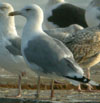 Larus cachinnans 5CY KN76 September 25 2010, Jastarnia, Poland. Picture: Michal Rycak.
Larus cachinnans 5CY KN76 September 25 2010, Jastarnia, Poland. Picture: Michal Rycak. Larus cachinnans adult, September 10-20 2010, Preila Pier - Neringa Spit, Lithuania. Picture: Chris Gibbins.
Larus cachinnans adult, September 10-20 2010, Preila Pier - Neringa Spit, Lithuania. Picture: Chris Gibbins.  Larus cachinnans adult, September 11 2011, Baku, Azerbaijan. Picture: Chris Gibbins.
Larus cachinnans adult, September 11 2011, Baku, Azerbaijan. Picture: Chris Gibbins. 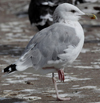 Larus cachinnans adult, September 10-20 2010, Preila Pier - Neringa Spit, Lithuania. Picture: Chris Gibbins.
Larus cachinnans adult, September 10-20 2010, Preila Pier - Neringa Spit, Lithuania. Picture: Chris Gibbins.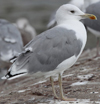 Larus cachinnans adult, September 10-20 2010, Preila Pier - Neringa Spit, Lithuania. Picture: Chris Gibbins.
Larus cachinnans adult, September 10-20 2010, Preila Pier - Neringa Spit, Lithuania. Picture: Chris Gibbins. Larus cachinnans adult, September 10-20 2010, Preila Pier - Neringa Spit, Lithuania. Picture: Chris Gibbins.
Larus cachinnans adult, September 10-20 2010, Preila Pier - Neringa Spit, Lithuania. Picture: Chris Gibbins. Larus cachinnans adult, September 10-20 2010, Preila Pier - Neringa Spit, Lithuania. Picture: Chris Gibbins.
Larus cachinnans adult, September 10-20 2010, Preila Pier - Neringa Spit, Lithuania. Picture: Chris Gibbins. Larus cachinnans adult, September 10-20 2010, Preila Pier - Neringa Spit, Lithuania. Picture: Chris Gibbins.
Larus cachinnans adult, September 10-20 2010, Preila Pier - Neringa Spit, Lithuania. Picture: Chris Gibbins.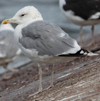 Larus cachinnans adult, September 10-20 2010, Preila Pier - Neringa Spit, Lithuania. Picture: Chris Gibbins.
Larus cachinnans adult, September 10-20 2010, Preila Pier - Neringa Spit, Lithuania. Picture: Chris Gibbins. Larus cachinnans adult, September 10-20 2010, Preila Pier - Neringa Spit, Lithuania. Picture: Chris Gibbins.
Larus cachinnans adult, September 10-20 2010, Preila Pier - Neringa Spit, Lithuania. Picture: Chris Gibbins. Larus cachinnans adult, September 10-20 2010, Preila Pier - Neringa Spit, Lithuania. Picture: Chris Gibbins.
Larus cachinnans adult, September 10-20 2010, Preila Pier - Neringa Spit, Lithuania. Picture: Chris Gibbins. Larus cachinnans adult, September 10-20 2010, Preila Pier - Neringa Spit, Lithuania. Picture: Chris Gibbins.
Larus cachinnans adult, September 10-20 2010, Preila Pier - Neringa Spit, Lithuania. Picture: Chris Gibbins. Larus cachinnans adult, September 10-20 2010, Preila Pier - Neringa Spit, Lithuania. Picture: Chris Gibbins.
Larus cachinnans adult, September 10-20 2010, Preila Pier - Neringa Spit, Lithuania. Picture: Chris Gibbins. Larus cachinnans adult, September 10-20 2010, Preila Pier - Neringa Spit, Lithuania. Picture: Chris Gibbins.
Larus cachinnans adult, September 10-20 2010, Preila Pier - Neringa Spit, Lithuania. Picture: Chris Gibbins. Larus cachinnans adult, September 10-20 2010, Preila Pier - Neringa Spit, Lithuania. Picture: Chris Gibbins.
Larus cachinnans adult, September 10-20 2010, Preila Pier - Neringa Spit, Lithuania. Picture: Chris Gibbins. Larus cachinnans adult, September 10-20 2010, Preila Pier - Neringa Spit, Lithuania. Picture: Chris Gibbins.
Larus cachinnans adult, September 10-20 2010, Preila Pier - Neringa Spit, Lithuania. Picture: Chris Gibbins. Larus cachinnans adult, September 10-20 2010, Preila Pier - Neringa Spit, Lithuania. Picture: Chris Gibbins.
Larus cachinnans adult, September 10-20 2010, Preila Pier - Neringa Spit, Lithuania. Picture: Chris Gibbins. Larus cachinnans adult, September 10-20 2010, Preila Pier - Neringa Spit, Lithuania. Picture: Chris Gibbins.
Larus cachinnans adult, September 10-20 2010, Preila Pier - Neringa Spit, Lithuania. Picture: Chris Gibbins.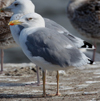 Larus cachinnans adult, September 10-20 2010, Preila Pier - Neringa Spit, Lithuania. Picture: Chris Gibbins.
Larus cachinnans adult, September 10-20 2010, Preila Pier - Neringa Spit, Lithuania. Picture: Chris Gibbins. Larus cachinnans adult, September 10-20 2010, Preila Pier - Neringa Spit, Lithuania. Picture: Chris Gibbins.
Larus cachinnans adult, September 10-20 2010, Preila Pier - Neringa Spit, Lithuania. Picture: Chris Gibbins. Larus cachinnans adult, September 10-20 2010, Preila Pier - Neringa Spit, Lithuania. Picture: Chris Gibbins.
Larus cachinnans adult, September 10-20 2010, Preila Pier - Neringa Spit, Lithuania. Picture: Chris Gibbins. Larus cachinnans adult, September 10-20 2010, Preila Pier - Neringa Spit, Lithuania. Picture: Chris Gibbins.
Larus cachinnans adult, September 10-20 2010, Preila Pier - Neringa Spit, Lithuania. Picture: Chris Gibbins. Larus cachinnans adult, September 2010, Dumpiai dump - Klaipeda, Lithuania. Picture: Chris Gibbins.
Larus cachinnans adult, September 2010, Dumpiai dump - Klaipeda, Lithuania. Picture: Chris Gibbins.  Larus cachinnans adult, September 2010, Dumpiai dump - Klaipeda, Lithuania. Picture: Chris Gibbins.
Larus cachinnans adult, September 2010, Dumpiai dump - Klaipeda, Lithuania. Picture: Chris Gibbins.  Larus cachinnans adult, September 2010, Dumpiai dump - Klaipeda, Lithuania. Picture: Chris Gibbins.
Larus cachinnans adult, September 2010, Dumpiai dump - Klaipeda, Lithuania. Picture: Chris Gibbins. Larus cachinnans adult, September 2010, Dumpiai dump - Klaipeda, Lithuania. Picture: Chris Gibbins.
Larus cachinnans adult, September 2010, Dumpiai dump - Klaipeda, Lithuania. Picture: Chris Gibbins. Larus cachinnans adult, 12-20 September 2008, Mamaia, north of Constanta on the Black Sea coast of Romania. Picture: Chris Gibbins.
Larus cachinnans adult, 12-20 September 2008, Mamaia, north of Constanta on the Black Sea coast of Romania. Picture: Chris Gibbins.
 Larus cachinnans adult, 12-20 September 2008, Mamaia, north of Constanta on the Black Sea coast of Romania. Picture: Chris Gibbins.
Larus cachinnans adult, 12-20 September 2008, Mamaia, north of Constanta on the Black Sea coast of Romania. Picture: Chris Gibbins.
 Larus cachinnans adult, September 23 2011, Ashdod, Israel. Picture: Amir Ben Dov. Arrested moult in primaries?
Larus cachinnans adult, September 23 2011, Ashdod, Israel. Picture: Amir Ben Dov. Arrested moult in primaries?
 Larus cachinnans adult, 12-20 September 2008, Mamaia, north of Constanta on the Black Sea coast of Romania. Picture: Chris Gibbins. Portret.
Larus cachinnans adult, 12-20 September 2008, Mamaia, north of Constanta on the Black Sea coast of Romania. Picture: Chris Gibbins. Portret.

